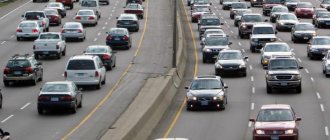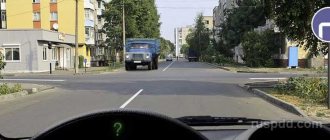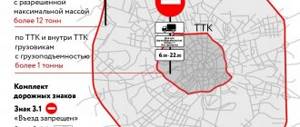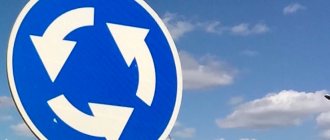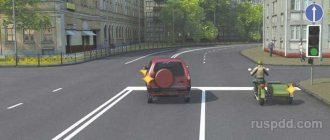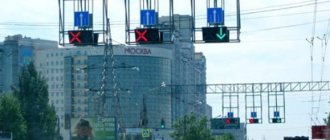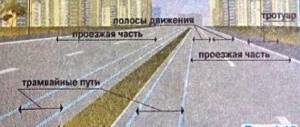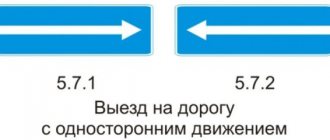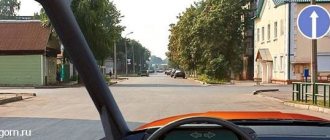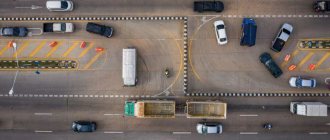What is reverse traffic, traffic rules
If we translate the word “reversus” from Latin, it means a written obligation.
In addition, this word can be translated as “the other side.” Today the word reverse is widely used in various fields. In taxation, it is understood as one of the types of repayment of debt obligations. The concept of reverse is also used in transport. According to traffic regulations, reverse traffic is the movement of cars in different directions on the same lane of the road. It should be noted that most often car owners learn about the peculiarities of organizing such traffic in traffic regulations, since in practice it is quite rare.
In Russia, most sections of roads with such traffic are just about to be launched. Only routes that can be classified as central have all the necessary road signs. To organize traffic, special markings are made and traffic lights are installed on the roads.
Reverse movement: features and organization
In Russia, this type of movement is a forced measure that has not yet become widespread. And also due to the lack of organization of drivers on the road, the likelihood of accidents in such areas is much higher, and therefore inspectors urge you to be more attentive in them.
The peculiarity of a reversible road is that traffic on one lane can be carried out in both directions, but at different periods of time. It is regulated depending on the situation by a traffic police inspector or a special traffic light. Most often, this solution can be observed during the period of road repair. In large cities, where the issue of congestion is especially acute, it is used to relieve congestion.
As mentioned above, such areas are characterized by an increased degree of risk. Driving in the reverse lane continues until the posted sign. You should be especially careful when turning right and changing lanes at an intersection that begins such movement into the far right lane. At the end of the movement on the right side, you must change lanes to the far right lane, even if you need to turn left. Failure to comply with the rule is punishable by a fine and recorded by a surveillance camera.
In addition, changing lanes into a lane with reversible traffic can be performed only if the traffic light is visible; all maneuvers are carried out when its permitting signal is given. There are several options for signal traffic lights: with two and three signs.
- A red crossed out signal indicates that travel is prohibited; this is also indicated by the complete absence of any signals.
- A yellow signal notifies you that you can still drive through, but it’s time to change lanes; if the signal becomes prohibitive after entering the lane, you should leave it as soon as possible.
- The green signal, according to tradition, is permissive.
How else can you determine that there is a reversible lane in front of you? For this, special markup is used. To highlight such stripes, a double broken line is used, with the gap intervals being three times shorter than the main stripes. This type of markup is labeled 1.9.
Using such a designation greatly complicates site recognition. This is primarily due to the fact that weather conditions often imply snow-covered roads. In addition, paint tends to wear off from asphalt. As a rule, if there are markings and there is no control traffic light, you cannot enter the reverse lane, but it is located in the middle of the road.
You can also find markings with special signs. A blue square with a double-sided arrow pointing both forward and backward indicates the beginning of such a section of the path. Accordingly, a similar crossed out sign indicates completion.
Why is reverse movement needed?
In the morning, motorists drive to their place of work, and at the end of the day they return home. It is at these moments that the most difficult traffic jams form. The rest of the time there may be no traffic jams on the city streets. That is, the load on the roads is uneven: it is constantly changing. Reversible traffic allows you to change street capacity as needed.
Translated from English, “reverse” means “reverse”. With this method of organizing traffic, there are stripes on the road surface along which cars can alternately move in one direction or the other. That is, reversible lanes are periodically “connected” to the main lanes, as if helping them pass traffic. The direction in which the path opens depends on where the bulk of the cars are moving. Due to this, the street capacity varies.
Reversing traffic is often organized at the exit from a populated area. Here it is especially relevant in the summer: when motorists leave the city before the weekend and return back on the eve of weekdays.
Start of reverse movement
To indicate the beginning of reverse traffic on the road, sign 5.8 :
You can and should see such a sign if you are driving on a road without reversible lanes, and this road becomes a road with reversible lanes, i.e. Reversing stripes appear right in front of you.
End of reverse movement
Sign 5.9 is used to indicate the end of reversible traffic on the road :
Such a sign should appear on the road in a situation opposite to the previous one, i.e. if you are driving on a road with reversible lanes, and the reversible lanes end there.
If you encounter a sign of 5.8 or 5.9, then you do not need to take any special actions.
Reversing traffic according to traffic rules
It’s enough to just figure out what reverse movement means. It involves driving in the same lane in different directions depending on the time of day.
There are a number of different issues that you will need to familiarize yourself with in advance - before you start driving on the road of the type in question.
Such questions include the following:
- means of adjustment:
- Signs.
- Marking.
- Traffic light.
- how the organization system works;
- penalty when entering the lane.
Adjustments
It is important to know that there are certain standards for driving on this type of road.
There are special means related directly to the direction of movement and its regulation during the time of day. These primarily include road signs, markings and traffic lights.
Signs
At the moment, there are as many as 3 different signs that are directly related to the regulation of traffic in lanes where reverse occurs:
| Sign No. 5.8 | Indicates road sign sign with reversible traffic |
| Sign No. 5.9 | Looks like a crossed out vertical double-sided white arrow, indicating the end of a road with reverse traffic |
| Sign No. 5.10 | A vertical double-sided arrow crossed out diagonally by a red line indicates the end of a road with reverse traffic. |
It is important to carefully monitor the presence of such signs on the road. Otherwise, you can simply confuse the direction of movement. The result is a fine or an accident.
Photo: sign 5.8
Photo: sign 5.9
Photo: sign 5.10
Marking
Reverse movement is indicated by special markings. It is designated by number No. 1.9 and is horizontal.
It consists of two broken lines parallel to each other. Typically, lanes for reversing traffic are marked not only by markings, but also by a special sign.
Photo: markup 1.9
This marking is used to separate traffic flows when traffic lights are turned off, which usually implement this function.
Traffic light
A reversible traffic light works in the same way as a regular traffic light. The color signals are completely identical.
Photo: reversible traffic lights
But it should be remembered that the effect of a reversible traffic light only applies to the lane with the corresponding traffic. When starting to move or change lanes, this point must be taken into account.
How the organization system works (travel rules)
Reversible lanes are usually used only during certain hours. In each city, the traffic pattern and time intervals may differ slightly.
The strip is highlighted by a double broken line, which is three times shorter than the main part. First of all, you need to focus on working traffic lights.
If a traffic light for reversing traffic is installed above a traffic lane and it is turned off, then the use of this lane for driving a car is prohibited.
Entry is only possible if the traffic light is working and the green arrow is active. Quite serious fines have been established for violating the rules for driving on reverse lanes.
A green traffic light means traffic is allowed, a red light means traffic is prohibited. At the same time, a yellow traffic light indicates a requirement to move into the adjacent lane.
Video: reverse movement
It is important to constantly monitor the position of the traffic light. Since reversing traffic involves driving along the same lane in both directions.
Penalty for leaving the lane
Serious fines have been established for violating the traffic rules on roads with reverse traffic. In this case, the amount of the fine is determined precisely by the type of violation itself.
For example, if for some reason the driver does not change lanes after leaving the lane with reverse traffic, then the fine will be 500 rubles.
This measure is provided for in Article No. 12.15 of the Administrative Code. The punishment is especially serious if the lane is entered at a prohibitory traffic light.
The fine in this case is 5 thousand rubles. The reason for such a large amount is that on the other side the traffic light can be turned on and cars will move.
There are many different nuances associated with the use of reverse movement.
Failure to comply with the established rules for entering the reverse lane is 1,000 rubles. This fine is determined by Article No. 12.12 of the Administrative Code.
Ways to organize traffic
In addition to signs, sections of the road with reversible traffic are indicated in the following ways:
- traffic light installed above the road. It may have two or three light sections. The double one consists of a green arrow (traffic is allowed) and a red cross (entry into the lane is prohibited). The triple display, in addition to these two sections, has a yellow arrow informing you about the need to change lanes in the direction in which it points. A yellow signal warns that the ban will soon turn on - that is why you need to change lanes to where the arrow is pointing;
- special markings - double intermittent (dotted).
The section with a taxiway must contain all three components: road signs, traffic lights (double or triple) and special markings . Using the reversible lane is quite simple: you just need to follow the traffic light instructions. Periodically, he allows one flow of traffic, then another, to enter the lane.
Road markings
There is a special double broken line indicating the reverse lane. If such markings are applied, additional signs will not be placed. However, if conditions exist that reduce the visibility of this lane marking, a variety of signs indicating this lane may be used. The markings can be located either on both sides of the traffic flow, or on the left side of the highway (in such a situation, a horizontal traffic light is required to regulate the direction of movement).
It is allowed to cross this marking if it is to the right of the car and the traffic light is not working.
How many reversible lanes are there on the road?
In practice, there are 2 options for applying reverse markings:
- The only marking line is 1.9 in the center of the road. In this case, 2 stripes are reversible. One located to the right of the marking and one located to the left.
- Several 1.9 marking lines on the road. In this case, reversible stripes are those that are limited on both sides by reverse markings.
It is curious that there are no signs to indicate reversible lanes. There is only a sign indicating a road with a reversible lane. But what lanes the traffic is on can only be judged by the markings. As for reversible traffic lights, they only regulate the order of movement and do not indicate lanes.
At the same time, under unfavorable road conditions (snow, mud, or markings worn out over time), problems may arise with determining boundaries or the presence of reversible lanes. After all, the absence of markings means the absence of stripes .
Reversible traffic light
Carefully change lanes to the far right; you need to be especially careful when driving through an intersection. Remember that all maneuvers of car owners on the site are recorded by video surveillance systems.
You can change lanes only if the authorized signal is working . This must be done within the visibility range of the reverse traffic light.
If the traffic light signal changes while your car is moving, you need to return to your lane as quickly as possible. When the prohibiting signal is turned on, the driver must leave the lane at any suitable moment.
It’s worth talking in more detail about turning from the strip. In the traffic rules you will not find any direct indication of the prohibition of these actions. But it should be taken into account that the same rules note that you need to pay attention to the location of line 1.9. If it is located to the driver's right and the traffic lights are on, then you can cross the line only if it separates lanes where traffic is allowed in one direction. We can say that it is strictly forbidden to cross the leftmost line 1.9, which is responsible for separating oncoming traffic.
Types of traffic lights
In the everyday view in Russia, a traffic light is a three-section light signal that allows or prohibits driving. In fact, the traffic rules distinguish seven different types of lighting devices, each of which has its own nuances, and the driver must correctly interpret their meanings.
These include:
- The three-section has three segments in which green, yellow or red signals light up. Reflects permission or prohibition to travel along the highway.
- The two-section is equipped with only two segments in which red and green are lit. Typically used to organize single-lane alternate traffic, as well as when entering and exiting closed areas.
- With an additional section - used to indicate a permitted turn when the alternative signal of the main traffic light is on.
- Single-section serves as a complement to other designations. Usually there is either an arrow on it or a ban in the form of a red signal.
- For pedestrian crossings with the image of human contours. They can be automatic or manually controlled, when the green light turns on at the request of a person.
- For trams and at railway crossings. White traffic lights giving the right of way to vehicles depending on the type of signal.
- A reversible traffic light that regulates certain areas of traffic.
The traffic light has a priority position among all road symbols; it is necessary to follow it and only in case of breakdown or switched off mode, follow the road signs. Sometimes, for example, in the case of a reverse road, a disabled device changes the situation on the highway, giving the road markings a different meaning.
The yellow light gives information to the driver that the signal will soon change, but does not imply that it is already permissible to begin maneuvers on the road.
The essence of a reversible traffic light
Recently, there are more and more cars on our roads, so regulating the flow and passage is more relevant than ever. The device can not only regulate, but also reduce the amount of congestion on the country's roads. As a result, when installing reversing devices, time is saved by streamlining the movement of traffic along lanes, and the amount of congestion is significantly reduced.
The word reversible itself is translated as returning. The essence of the device is to return traffic in two opposite lanes to the corresponding traffic light signal within one lane.
Most often, such devices are installed in narrow tunnels or during road repairs. If the traffic light is mounted above the road strip, then it allows for effective regulation of traffic along the roadway during repairs.
Traffic regulations on reverse traffic lights
A reversible traffic light is installed above the lane and gives only one light signal at a time. Depending on the number of lanes, a traffic light has one, two or more segments.
The signals are interpreted as follows:
- A green arrow, the tip of which is lowered, means driving in the lane is permitted.
- Red cross – cars are currently moving along the lane in the opposite direction, entry is prohibited.
- Yellow diagonal arrow pointing to the lower right corner - movement in the reverse lane ends and the driver should change lanes to the right lane.
The device is installed not only before the start of the section, but is also repeated throughout the entire road. Drivers are advised to pay close attention to the directions in order to spot the yellow arrow in a timely manner. The device may periodically turn off, in which case drivers should immediately leave the lane.
Not all reversible traffic lights are equipped with a yellow arrow function; sometimes the driver needs to navigate to the end of the row using road markings.
Traffic light signs
So, what do the reverse traffic light signs mean:
- A red cross indicates that the lane is prohibited. At this moment, traffic in the opposite direction is open. When this sign is on, any movement along the lane, including leaving it, is prohibited. If you ignore this prohibition, then there is a high probability of an accident occurring, as well as creating a traffic jam in this area;
- arrow to the right or left corner. When this indicator lights up, the driver can make a lane change maneuver in the direction the arrow is pointing. The sign may also indicate that the traffic light is about to change. It is worth considering one fact: the yellow color of this device does not indicate a prohibition, like a regular traffic light, it simply allows the vehicle to change lanes. At the same time, the driver can change lanes at will; the traffic light does not oblige this action;
- the green arrow seems to be clear to everyone - it means that movement in the lane is allowed. When this indicator is activated, the driver can enter the lane without fear and continue driving. But during this signal, the driver can no longer change lanes to another lane.
What to do if there are no reversible traffic lights?
Line 1.9 in the absence of reversible traffic lights or when they are turned off is allowed to cross if it is located to the right of the driver.
If there are reversible markings, but there are no traffic lights, then there is no need to enter the reversible lanes, marked with markings on both sides.
After reading this article, you will be able to easily determine whether there are reversible lanes on the road, as well as what their number is. Well, the next article in the series will look at road signs on roads with reverse traffic.
Special characters
Signs are the main regulatory element of traffic management on the reverse lane. These signs include:
- Sign 5.8. It is installed at the boundaries of the intersection if the reversible lane goes further after it.
- Sign 5.9. Indicates the completion of a section of the highway on which two-way traffic is permitted.
- 5.10. It is located in places through which cars enter the lane from nearby streets.
When movement in both directions is possible only at specific time intervals, along with the signs, signs indicating this time are installed. In some situations, signs are placed with information that a reversible lane begins on this part of the road.
Organization of reverse movement using parapets
Researchers have noticed that most accidents occur between 18:00 and 21:00. This is due to the maximum traffic congestion during this period. Offices and institutions are closing, tired workers are rushing home. Also, accidents often occur in the morning for the same reason - fatigue. But this is not the only problem with high accident rates.
Nowadays, markings and traffic lights are not enough to ensure normal reverse traffic, so it is worth taking an example from Europe and introducing a system for preventing collisions between vehicles in different directions on a large scale. These are parapet-type blocks that consist of concrete structures.
They help to protect free lanes on the oncoming side of the road, which allows cars to increase speed by about 25 km/h during peak loads. The barriers are installed on the road surface and secured with rubber pads.
There are fences of constant and variable length. Blocks of variable length are installed on curved sections of the road. They are made of steel and are completely welded.
Primary assembly and installation is carried out using a forklift. Using special fasteners and pins, the structural elements are connected and adjusted to the required dimensions.
Road barriers are moved to the installation site using a special machine. Thanks to these mobile units, there is no need to divide road markings into sections for reverse traffic.
How is reverse regulated?
Russian legislation on sections of roads with reversible lanes necessarily requires the installation of specialized traffic signs, the application of special marking lines and the installation of a specific traffic light. Now we need to consider in more detail each of these integral attributes separately.
Sign 5.8 “Road with reversible traffic”
Reversing signs
about the new warning triangle and its differences from the old version here
Based on the priority rules, road signs come first. At the beginning of a section of a road with a reverse direction, a rectangular road sign is placed, very similar to the “Traffic only straight ahead” sign, on a blue background of which there is a vertically located two-pointed arrow. The sign must be placed at the very beginning of the part of the road with reverse traffic and its effect extends to the sign that marks the end of the reverse. So what does the reverse sign mean? The indicated road sign indicates that you are moving along a section of the road on which driving is only permitted in a strictly indicated direction. Very often, reverse signs are supplemented by signs that draw the driver’s attention, also indicating a specific time period or days when reverse movement occurs on the lane.
Reversible traffic light
Reversible traffic lights
the fine for speeding here
In the morning, everyone rushes from home to work, and in the evening, it’s the other way around. And in order to avoid hours-long traffic jams, special lanes are being introduced. Traffic regulation is carried out by means of a traffic light, a traffic police officer or road workers. Sometimes these traffic lights are used in tunnels. Installed above the rows, they make it possible to regulate traffic on the lanes in a short period of time during road accidents or during repair work on the roadway. Next, let's take a closer look at the features of the traffic light itself, which regulates reverse traffic. This is not the traditional traffic light that you are familiar with, installed at all major intersections. A traffic light regulating reverse traffic is installed directly above the lane. It can be either two-section or divided into three sections. An “X” that lights up in prohibitive red color indicates a strict ban on any movement along the lane underneath it. A green arrow that lights up will allow driving in the indicated lane. In traffic lights divided into 3 sections, you can see an arrow that lights up yellow; this arrow indicates the direction in which you should change lanes. In a situation where the reversing traffic lights are turned off, you should move into the far right lane as quickly as possible, otherwise this will be considered a very significant violation of the rules.
Reverse markup 1.9
Reversible marking 1.9 (double dashed line)
You can read about the fine for driving without license plates
Now it remains to consider the features of the markup. That is, a reversible lane is a lane in which any movement is allowed only in the prescribed direction. The above-mentioned lanes usually have a central position on the road and are located only within the city limits. The road marking for the reversible lane is indicated by a double broken line. The rules allow crossing such lines only if the double broken line is located to the right of the driver.
What are the advantages and disadvantages of reversible stripes?
This type of strip has both advantages and disadvantages. Among the advantages of RD are:
- a general increase in traffic speed by 20%, and accordingly a decrease in congestion;
- traffic coordination and reduction of traffic congestion in large cities;
- the ability to use at certain times of the day or on set days;
- space saving, since one lane is used for both directions of traffic and can only be switched on when necessary.
There are also disadvantages:
- The likelihood of an accident due to inattention or insufficient knowledge of traffic rules among drivers increases.
- Due to the fact that in Russia the reverse system is not as widely developed as in Europe, many motorists (for example, visitors from smaller cities) may become confused - this also leads to an increased risk of accidents.
If we compare the pros and cons of this type of traffic, we can conclude that all the disadvantages stem from insufficient driving skills: experience, attentiveness, knowledge of the rules.
Traffic regulations for reversible sections
For safe driving you need to remember the following rules:
- It is prohibited to stop on the taxiway strip.
- You can only enter the taxiway lane when the traffic light is permissive, since when the traffic light is prohibited, oncoming traffic moves. Accordingly, entering the lane at this moment will be equivalent to entering the oncoming lane.
- If the traffic light is not working, then you cannot enter the taxiway lane. If the system is faulty, this section of the road surface can only be used by emergency vehicles (fire, ambulance, etc.).
- If the traffic light is not visible, then there is no need to take risks: it is better to stay in your lane. The same applies to moments when, due to bad weather or for other reasons, the markings are not visible or have been erased.
- Overtaking can be done taking into account clause 11 of the Russian Traffic Regulations.
- You cannot cross the leftmost marking 1.9.
- Entry onto a reverse road from an intersection or a turn is made from the far right lane, but not from the taxiway lane (this is considered a violation).
- A reverse turn can be made if the 1.9 marking does not separate the lanes that are intended for driving in oncoming directions.
Entering the lanes
Driving into the reversible lane is permitted if the following conditions are met:
- The presence of a working traffic light where the color is green.
- Installed sign 5.8.
In the second case, it is important to look at the pointer that is located near the symbol. So, under 8.5.1, you can enter the strip only on holidays and weekends. In the absence of an auxiliary sign, the traffic light will serve as a guide, or a traffic controller should be located in this area.
If there is no prohibition, then you can enter the driving lane in any direction from all directions. You can only leave it in the far right lane.
At the traffic light
Reversing traffic is characterized by a special traffic light. Usually it has two signals - green and red. Red prohibits entering a lane with a changing direction, driving along it, or requires moving to the right if the car is already there. Green allows you to move along the lane. There may also be a yellow signal at the traffic light. It means that the direction of movement will soon change. Each lane, if there are several of them, will be equipped with a separate traffic light.
If there is a traffic light, but it does not work, and the 1.9 marking is only on the left, the multifunctional row becomes normal. If the device is turned off and the line is in the middle of the road, driving is prohibited.
Driving over the bridge
When driving on a reversible system on a bridge, the rules will be the same as when driving on a regular part of the road. It is possible to select one or several rows with or without a change in direction. When driving in reverse on a bridge, you need to rely on road signs, markings and traffic lights.
At the crossroads
Difficulties with reversing traffic at an intersection are usually related to how you need to turn in this area:
- If you are entering a road intersection with the beginning of a lane with a changing direction, you must first take the rightmost position. Only after turning from it can you change to reverse movement.
- If the car is already driving in the reversible lane and the intersection requires you to go straight, the rules will be similar to normal traffic in that zone. That is, you must be guided by the signals of a regular traffic light. In the absence of one, you need to give way to a car that is moving on the right (if the roads are equivalent) or driving on the main road.
- If a car is driving in reverse and needs to turn at an intersection, this is done from the outer lane on the right. In this case, in which direction the car plans to move does not matter.
Other reverse features
In addition to what has already been said, reverse movement involves the following rules:
- It is possible to overtake other cars on a multifunctional lane, but this must be done taking into account paragraph 11 of the Road Traffic Rules.
- Entering the reverse lane, which is limited on both sides by markings 1.9 when the traffic light is off or the red signal, can be equated to driving in the oncoming lane.
- A U-turn from the reverse lane can be made if the 1.9 marking does not separate the lanes that are intended for driving in oncoming directions.
The concept of reverse movement
The concept of reverse movement was introduced into traffic rules relatively recently. But now the question about it is included in the tickets when a person passes his license.
In fact, this is a separate lane, which remains empty during normal traffic without congestion on the highway. Special vehicles and cars with special privileges in the form of warning beacons, sirens, etc. can pass through it. Regular drivers are not allowed to enter there unless the traffic situation provides otherwise. Since the lane serves to relieve traffic, it is not recommended to drive onto it just like that.
If you live in a residential area of a metropolis, go to work in the center, and return home in the evening, the following situation will be painfully familiar to you.
First, there are morning traffic jams on the way to your workplace, and then the same traffic jams where you are stuck with almost the same drivers, trying to get to your family, lie down in your own bed and rest. And tomorrow everything will happen again.
Reversing movement allows us to partially solve this problem, when most of the cars move in one direction, and a smaller part in the opposite direction. Objectively, it’s a shame when you’re stuck in a traffic jam, and traffic in the opposite direction is practically free. To compensate for this disadvantage, this very reverse movement is used. Depending on conditions or time of day, this lane can be used in both directions. Such bands have been in use for a long time in the USA and Europe, and only recently began to be implemented here.
It is equally important for a novice driver and an experienced motorist to understand the innovations.
To begin with, I propose to understand the features of informing motorists about reverse traffic (RD).
Special markup
You drive calmly around the city, looking at the markings. And sometimes it seems extremely the same.
How then can we understand that this or that band is reversible? It's quite simple. There are special requirements and standards regarding what specialized markup looks like. Here a double broken line is used. Be sure to remember it, because otherwise there is a big risk of realizing too late that you have entered the wrong lane. This is especially dangerous when there is oncoming traffic on it.
The markings are applied between regular lanes that separate vehicles moving in the opposite and the same direction as you. In fact, this is a dedicated lane in the middle of a highway or city road.
The problem with markings is that they can wear off over time and become covered with snow in winter. Therefore, it is extremely important to have additional indicators in the form of signs and traffic lights.
There is also a marking without a dedicated stripe in the center, but simply with a double broken stripe. This suggests that in such areas, reversing is possible provided that the appropriate traffic lights are turned on. And then cars from the oncoming traffic have the right to occupy the lane in which you are moving. Or vice versa. If each direction had 2 lanes, when reversing, some are given 3, while others move only on 1 lane.
Signs
If you look at the photo, you can see 3 different signs or indicators that are used to designate roads with reversible traffic.
- Sign 5.8 is installed at the very beginning of the allocated lane. Indicates the beginning of a reversible road. It can be used to determine where the corresponding section begins. This is a white square with a blue background and a white arrow, the pointer on which is directed in both directions (up and down);
- 5.9. With the help of such a sign, the driver understands that the reversible traffic zone is ending. Looks almost exactly the same. Only there is also a red line crossing out the arrow;
- 5.10. This sign indicates that you are entering the road from the taxiway. Here the shape and colors are the same as for 5.8, only the arrows are directed left and right.
Such signs can be supplemented by explanatory signs if the direction of movement changes depending on the time of day or days of the week.
Traffic light
According to traffic regulations, special traffic lights are used to determine the directions and rules for moving along taxiway lanes.
There are a few important points you should know about them:
see also
How to make eyelashes for headlights with your own hands: manufacturing options
- You should follow the signals of reversible traffic lights only in those lanes above which they are installed;
- The permission signal is a green arrow pointing down. This gives the driver the right to drive in that lane;
- On the contrary, the Red Cross prohibits traffic on the taxiway;
- Using a yellow arrow tilted to the left or right, it shows which way the driver should change lanes (the red signal will turn on soon).
But all this applies only to active traffic lights that are on. If the signs are turned off, then driving onto the taxiway is prohibited. As soon as you see that the permissive signal has changed to a prohibitive one, that is, the green arrow has changed to a red cross, you should immediately leave the reverse lane. There is a possibility that the RD was turned on for the opposite side. If you remain in this lane, there is a risk of a head-on collision.
